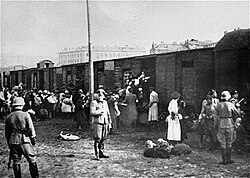This is an old revision of this page, as edited by Grutness (talk | contribs) at 10:10, 3 December 2010. The present address (URL) is a permanent link to this revision, which may differ significantly from the current revision.
Revision as of 10:10, 3 December 2010 by Grutness (talk | contribs)(diff) ← Previous revision | Latest revision (diff) | Newer revision → (diff)

In the Holocaust, the Umschlagplatz (Template:Lang-de) in the Warsaw Ghetto was where Jews gathered for deportation to the Treblinka extermination camp.
During the Grossaktion Warsaw, beginning on July 22, 1942, Jews were deported in crowded freight cars to Treblinka. On some days as many as 7,000 Jews were deported. An estimated 265,000 Warsaw Jews were taken to the Treblinka gas chambers, and some sources describe it as the largest killing of any single community in World War II. The deportations ended on September 12, 1942.
The Umschlagplatz was created by fencing off a western part of the Warszawa Gdańska freight train station that was adjacent to the ghetto. The area was surrounded by a wooden fence, replaced later by a wall. Railway buildings and installations on the site as well as a former homeless shelter and a hospital were converted to the prisoner selection facility. The rest of the train station served its normal function for the rest of the city during the deportations.
In 1988, a stone monument resembling an open freight car was built to mark the Umschlagplatz. The monument was created by architect Hanna Szmalenberg and sculptor Władysław Klamerus.
External links
52°15′08″N 20°59′21″E / 52.2523083333°N 20.9890777778°E / 52.2523083333; 20.9890777778
This Masovian Voivodeship location article is a stub. You can help Misplaced Pages by expanding it. |
This article related to the Holocaust is a stub. You can help Misplaced Pages by expanding it. |